
So, reading this Newsletter, you will know everything about ALADIN activities (more precisely everything I was told about) between January 1998 and March 1998 (except for the work realized outside Toulouse : between October 1997 and December 1997).
Please do bring to my notice anything that you would like to be mentioned in the next Newsletter (number 11) before the 20th of July 1998.
Any contribution concerning announcements, publications, news from the ALADIN versions on workstations or on big computers, verifications results, ... will be welcome. This deadline is particularly important for the report of the deported work each representative should sent every quarter.
If needed, please contact : Patricia POTTIER CNRM/GMAP METEO-FRANCE 42, avenue Gustave Coriolis F-31057 TOULOUSE-CEDEX Tél : (33) 5 61 07 84 74 ; fax: (33) 5 61 07 84 53 (from France replace 33 by 0) email: Patricia.Pottier++at++meteo.fr.
Many thanks for all of you who have sent me most of the informations reported here. Contents
|
Main events ..................................................................................................................... |
3 |
|
1. Major change in the ALADIN code (last episode and success) ............................................. |
3 |
|
2. The first "ALADINthèque" ............................................................................................... |
3 |
|
Conferences/Workshops/Announcements ................................................................... |
4 |
|
1. ALADIN Workshop on "Various implementation of the model within ALADIN partners" | |
|
held in Toulouse on February 18-20th, 1998 .................................................................. |
4 |
|
2. HIRLAM Workshop on "Variational Analysis in Limited Area Models" held in Toulouse on | |
|
February 23-25th 1998 .................................................................................................... |
4 |
|
3. ALADIN Workshop on "Exploitation and future development of the NWP model ALADIN" | |
|
to be held in Prague on June 10-12th, 1998 .................................................................... |
5 |
|
4. EWGLAM/SRNWP meetings to be held in Copenhagen on October 5-9th, 1998 .................... |
5 |
|
Contacts & Informations .............................................................................................. |
6 |
|
Money Funding asked for some cooperations based on the ALADIN project ........ |
6 |
|
1. INCO-COPERNICUS keep-in-touch, so-called "ALADIN-KIT" .................................... |
6 |
|
2. Embassies support ............................................................................................................ |
6 |
|
The (pre-) operational ALADIN models on big computers ..................................... |
7 |
|
1. ALADIN-Belgium ........................................................................................................... |
7 |
|
2. ALADIN-France ............................................................................................................. |
7 |
|
3. ALADIN-LACE in Météo-France ................................................................................... |
7 |
|
4. ALADIN-LACE in CHMI ............................................................................................... |
8 |
|
5. ALADIN-Maroc ............................................................................................................. |
8 |
|
The ALADIN models on workstations : ....................................................................... |
9 |
|
1. The AWOC-group ............................................................................................................ |
9 |
|
2. in Austria .......................................................................................................................... |
9 |
|
3. in Bulgaria ......................................................................................................................... |
10 |
|
4. in France ........................................................................................................................... |
10 |
|
5. in Hungary ........................................................................................................................ |
10 |
|
6. in Poland ........................................................................................................................... |
11 |
|
7. in Portugal ......................................................................................................................... |
13 |
|
8. in Romania ........................................................................................................................ |
13 |
|
9. in Slovakia ......................................................................................................................... |
14 |
|
10. in Slovenia ....................................................................................................................... |
14 |
|
"Réseau Formation Recherche" : PhD Studies .......................................................... |
16 |
|
1. Doina Banciu ..................................................................................................................... |
16 |
|
2. Marta Janiskova ................................................................................................................ |
16 |
|
3. Ilian Gospodinov ................................................................................................................ |
16 |
|
4. Filip Vana .......................................................................................................................... |
16 |
|
5. Mark Zagar ....................................................................................................................... |
17 |
|
About ISBA ...................................................................................................................... |
18 |
|
Subjective evaluation system of ALADIN at Hungarian Meteorological Service | |
|
Experiences for the period 1 June 1997 - 31 December 1997 ..................................... |
24 |
|
Scores on ALADIN-FRANCE during the first quarter of 1998 ............................... |
30 |
|
Participations in the ALADIN project : Deported developments during the last | |
|
33 | |
|
1. in Austria .......................................................................................................................... |
33 |
|
2. in Belgium ......................................................................................................................... |
33 |
|
3. in Bulgaria ......................................................................................................................... |
33 |
|
4. in Croatia .......................................................................................................................... |
34 |
|
5. in Czech Republic .............................................................................................................. |
34 |
|
6. in Hungary ........................................................................................................................ |
34 |
|
7.in Morocco ........................................................................................................................ |
34 |
|
8. in Poland ........................................................................................................................... |
34 |
|
9. in Portugal ........................................................................................................................ |
35 |
|
10. in Romania ...................................................................................................................... |
35 |
|
11. in Slovakia ....................................................................................................................... |
35 |
|
12. in Slovenia ....................................................................................................................... |
35 |
|
13. by Météo-France people .................................................................................................. |
36 |
|
Participations in the ALADIN project : ALADIN developments in Toulouse | |
|
1. Main events in Toulouse this quarter .................................................................................... |
36 |
|
2. Visitors research or development studies .............................................................................. |
36 |
|
3. Research or development studies by the Toulouse permanent staff .......................................... |
37 |
|
Annexes ............................................................................................................................. |
38 |
|
1. List of the documents available on the public ftp ..................................................................... |
38 |
|
2. Total participation : breakdown of person.months by countries ................................................ |
39 |
|
3. Toulouse/Deported work since the last quarter of 1995 ........................................................... |
40 |
|
4. Total participation : breakdown of the Toulouse/Deported person.months by countries .............. |
41 |
|
5. Evolution of the Toulouse monthly manpower ........................................................................ |
42 |
1. Major change in the ALADIN code (last episode and success)
|
|
The former surface parametrization of ALADIN has been replaced by a more realistic and advanced one, the so-called "ISBA stuff" (please find some more details about ISBA in the relevant summary ). Besides its scientific aspects, this change was a real challenge as it needed a simultaneous switch in the ARPEGE suite and in all the operational or pre-operational ALADIN suites. Many people were involved in this operation and on Tuesday 17th of March, it was ... a complete success. |
2. The first "ALADINthèque"
|
A major effort has been made to collect and synthesize the available documentation in paper format in Toulouse. 88 notes, papers and reports have been compiled, with an abstract for each. This collection, the so-called ALADINthèque in French, provides a bibliographical support for all the developers in Toulouse. It might be also a useful starting point for a future computer database, though the text files themselves have not been compiled. To give an idea about the difficulty of this work, we can simply mention that the present list of documents was almost out of date the very day it was made |
|
|
public in Toulouse ... Note that the prompt realization of this list was made possible thanks to Florence Nicoleau's support. The list of the contents of this ALADINthèque is available on the usual public ftp : aladintheque.ps. It should be updated regularly. If you are interested in one of the document referenced in this list, please contact Claude Fischer who will send you the corresponding paper copy. For more recent documents, the effort to keep also the corresponding postscript or text files should lead to an easier access. | |
|
1. ALADIN Workshop on "Various implementation of the model within ALADIN partners" held in Toulouse on February 18-20th, 1998 During this three-day meeting, more than 35 persons attended different oral presentations or demonstrations and learned nearly everything about : |
| |
|
|
the current state of eleven implementations of ALADIN in different countries, either on big computers or on workstations; the available applications in the ALADIN environment such as VERIF.PACK, ASCS and CHAGAL, Tkcs, dynamical adaptation, observation file handling and some operational control tools; | |
|
the historical account of portability of ALADIN, an overview of hardware able to run ALADIN, ALADIN future in distributed memory. An important part of the workshop was dedicated to different discussions on : observation files and verification; | ||
|
|
post-processing content and graphics; documentation; static oriented-diagnostic CANARI; satellite movie; GRIB on workstation; | |
|
AWOC : redefinition of the AWOC-committee and its objectives; training; ... | ||
The Minutes of these discussions have been sent to the representative of each country and are available on the usual public ftp. Participants were given a paper copy of oral presentations transparencies at the end of the meeting. Others copies can be sent on request.
Off workshop, a SAC/LACE took place during the Thursday evening. Some participants stayed in Toulouse a few days more to attend the "HIRLAM meeting on variational analysis in LAM".
2. HIRLAM Workshop on "Variational Analysis in Limited Area Models" held in Toulouse on February 23-25th, 1998
A HIRLAM workshop on "Variational Analysis in Limited Area Models" has been organised in Meteo-France on 23-25 february 1998. Several presentations were given by invited specialists and by HIRLAM Project participants.
ALADIN model was present in these presentations. Loïk Berre presented "the non-separable multivariate structure functions in the ALADIN system" and Marta Janiskova showed some the results of some "4D-Var experiments with simplified physics at Météo-France".
The workshop presentations were followed by discussions in three groups,
with the following themes for discussion: (1) Balance constraints and
treatment of lateral boundary conditions in limited area models; (2) Use of
observations and surface analysis; (3) 4D-VAR for limited area models. The
discussions were aiming at giving recommendations to the HIRLAM project in the
development of their variational system. Abstracts of the presentations as
well as recommendations from the working groups will be gathered in the
workshop proceedings shortly.
|
3. ALADIN Workshop on "Exploitation and future development of the NWP model ALADIN" to be held in Prague on June 10-12th, 1998 |
|
|
Host by the Czech Hydrometeorological Institute, this workshop will essentially deal with the following topics : |
Round-table discussions will also be organized on :
Further information can be found of the very nice WWW pages cooked up for this workshop by Martin Janousek. Its address is : http://www.chmi.cz/meteo/ov/workshop/ .
For any questions, please contact Martin Janousek.
4. EWGLAM/SRNWP meetings to be held in Copenhagen on October 5-9th, 1998
Organized by the Danish Meteorological Institute, the next combined EWGLAM/SRNWP meetings will take place in Copenhagen. The special topic of these meetings will be "Experiences with very high resolution models using a grid point distance below 10 km".
A very practical information due to our experiment once trying to book plane tickets from some Eastern European Countries : planes are already very crowded for the period of the meeting; be careful!.
These informations (and others, please see the list of the documents in annexe) are available on a public ftp : cnrm-ftp.meteo.fr, under the directory /pub-aladin. Please connect on user anonymous and use you e-mail address as your password.
Some mailing also lists exist to make our correspondence smoother; for example, the general list aladin++at++meteo.fr.
|
|
1. INCO-COPERNICUS keep-in-touch, so-called "ALADIN-KIT" A report on the ALADIN activities during the first half of the ALADIN-KIT contract has been sent to the EEC. The second (and last) part of the funding from the ALADIN-KIT will be used for financing participations to the following meetings : - Workshop in Prague (June 1998), - EWGLAM/SRNWP in Copenhagen (October 1998). The arrangement is similar to the arrangement during the EWGLAM 97 meeting. The Meteorological Services entitled for receiving the KIT funding have indicated their representative for these two meetings. For more details, please contact Dominique Giard. 2. Embassies support |
|
planned until June 1998. | |
For 1998 funding have been sent to the Minister for most of the countries. More details can be asked to Arlette Rigaud (Météo-France/DGS/IE, arlette.rigaud++at++meteo.fr ).
For 1998 funding, new rules have been prescribed for the use of embassy support : money will be available early in the year without possibility of report during the first months of the following year. Concretely, these stays on 1998 embassy support should be completed in 1998 (they should at least begin in 1998.
This situation is especially difficult as we will have to complete all stays on 1998 support during very few months : in July and especially in August, most of people will be on holidays and very few candidates are willing to stay in Toulouse at the end of December. Most of these stays will took place between September and December and... the new phasing will also take place during this period.
3. The operational implementation of ALADIN-Belgium (more details Luc Gerard )
4. Operational ALADIN-FRANCE in Météo-France (more details Bruno Lacroix )
A new parallel suite is now available for ALADIN-FRANCE, like the ARPEGE one, and produces for test version GRIB files in BDAP (FRANP01 domain). The parallel suite configuration is as close as possible to the operational one at 00UTC, and may be coupled with an ARPEGE test version.
This new tool is usefull to validate the impact of any modification either on ARPEGE or ALADIN, both compared to SYNOP and TEMP observations over the ALADIN-FRANCE domain. Please find some more details about this new tool in "Scores on ALADIN-France " and an example of its application in the article about ISBA.
Nowadays, SYNERGIE is not able to give access to this "new model". Actually, the enhancement of SYNERGIE is the last action which still need to be completed, in order to take advantage of ALADIN-FRANCE in Toulouse and in the seven French regional meteorological centres.
5. Pre-Operational ALADIN-LACE in Météo-France (more details Radmila Bubnova )
In the first quarter of 1998, the Toulouse Team work was ensured by Maria Siroka (1st January - 31st January), and by Radmila Bubnova (1st February - 31st March).
The cycle AL08/CY18T1 became operational on 10th February 1998 for the 12 UTC run after a successful test in the parallel suite. The scores were neutral with respect to the previous cycle: this was expected since the scientific content of the applications based on the previous and the new library was the same.
However the cycle AL08/CY18T1 enables among other things to use the more sophisticated Interface-Soil-Biosphere-Atmosphere (ISBA) scheme and one of the special tasks of the Toulouse Team was the creation of the new "ISBA type" physiography data for each ALADIN domain in use, in other words the creation of the ISBA climatological files for the concerned domains.
Again in connection to ISBA, it was necessary to move the verification tool "VERIF.PACK" to the use of AL08/CY18T1 library and to validate it.
6. Future ALADIN-LACE in CHMI (more details : Martin Janousek )
The ALADIN version 8 has been installed on the CHMI's computing server NEC SX4/3A (3 vector processor 2 GFlops/s each, 4 GB of shared memory). Further, the suite for the model operations is being developed and currently runs in the testing mode. The model configuration is an exact copy of the current ALADIN/LACE version running on J916 at Meteo-France for RC LACE.
7. Operational ALADIN-Maroc in MAROC-Météo (more details Mehdi Elabed )
The ALADIN-MAROC is running operationally twice a day with data assimilation cycle and CANARI analysis. Now, the Meteorological Data Base (BDM) is installed and the assimilation is using local CMAFOC file ( SYNOP, SHIP, SYNOR in the whole domain of ALADIN) which is completed with the ARPEGE reduced CMAFOC file received from Toulouse by the 64 kbyte data link. The project of installing an analyzed and forecasted data base (BDAP) is in progress.
For developing operational task, studies of installing a statistical adaptation and control model are in progress.
The model is running with the cycle cy18t1_al08 and with ISBA assimilation cycle and it is using a two time level semi-Lagrangian scheme with a time step of 675s and a horizontal resolution of about 16 km.
For the model development, efforts are focused on the amelioration of the forecast of precipitations. Thus a study for introducing the analysis of specific humidity in CANARI is ending and another study about closure convection is under investigation. Interest is also given to regional forecasting, so a project of running a nested ALADIN model with high resolution is being held.
Most of the ALADIN partners are involved in everyday ALADIN runs on workstation. For some of us, it is just the beginning of a long but so promising work. For others, it is a very recent reality or an old habit. This quarter, welcome to the Cracow forecast for the POLO domain.
In Toulouse also ... yes, THE ALADIN workstation is arrived in Toulouse !...
1. The AWOC-group
Part of the discussion held on Friday 20th February during the ALADIN Workshop on various implementations of the model was devoted to the Aladin WOrkstation Coordination group.
The need to redefine and reorganize the AWOC-group has been recognized, in particular the need to clarify its responsibilities and the way it should work. Some goals have been identified:
|
hold regular coordination meetings for technical questions and future plans (1 or 2 per year): link with scientific topics, definition of contents and scheduling for new developments. For this point, the coordination meetings between ECMWF and Météo-France could be the reference. | |
|
supervise the specific routines that need to be updated for WS and manage a WS-auxiliary library (10 to 20 routines). |
|
|
control that the WS developments are fed back into the main Ald-trunk at each major phasing. Members of the AWOC-committee were redefined : scientific person: Andras Horanyi gourou: Eric Sevault Toulouse team: Jean-Marc Audoin WS people: Jure Jerman, Liviu Dragulanescu multitask platform: Martin Janousek | |
2. Workstation version at Austrian Meteorological Service (more details Thomas Haiden )
The implementation of ALADIN-Vienna, is in the midst of compiling, testing automated ftp transfer, etc.. The first actual model run has not been made yet... but will be realized soon (more details in the next Newsletter).
3. Workstation version at Bulgarian Meteorological Service (more details Andrey Bogatchev )
At the end of February successful runs of ALADIN 07 were performed. Later in March, the ALADIN 08 was compiled and some tests were performed. A problem occurs at configuration EE927 : difference in the non ISBA fields on the western boundary of integration domain. Export package of ALADIN 08T3 and the correspondent bug fix version were implemented. The tests should be finished to the end of May.
4. Workstation version at French Meteorological Service (more details Jean-marc Audoin )
The workstation arrived in Toulouse in March is a SUN, the Fortran is a Fujitsu Fortran 90 compiler. The export Package AL08T1 was compiled. Its implementation is not really clean (for instance routines cpu). Some tests were performed on ee927 and e001 runs, but without all options.
5. Workstation version at Hungarian Meteorological Service (more details Andras Horanyi )
The most important event of the first quarter of 1998 is that the
workstation version of ALADIN was put into quasi-operational regime on 3rd of
February, 1998 (the domain can be seen in the attached pseudo-satellite
image). The application is called quasi-operational due to the fact that the
transfer of initial and boundary conditions are performed through Internet
connection.
|
The main characteristics of our application are as follows: 112 * 100 points (C+I zone) 8 * 8 points E-zone band 27 vertical levels 10.89 horizontal resolution 400 s time-step DFI + 48 hours integration twice a day coupled by ALADIN/LACE (6 hours frequency) online latitude/longitude FULLPOS (3 hours frequency) The main steps of the operational suite: Transfer of initial and lateral boundary conditions from Toulouse BDPE |
EE927 in Budapest
001 integration job with on-line FULLPOS
FA file conversion for visualization
movie preparation
preparation of meteograms
Products:
According to the first experiences the quasi-operational suite is running smoothly. At the beginning some failures were due to the slow Internet transfer, but since the transfer scripts were made more secure (possibility for restarting the transfer etc.) there were no problems encountered. Until now there was no failure due to the model. The change to AL08 and ISBA went without major difficulties.
6. Workstation version at Polish Meteorological Service (more details Marek Jerczynski )
In the end of 1997 year the ALADIN model - version Al07 - has been successfully ported to IBM SP2 supercomputer installed in Cracow Academic Computer Centre CYFRONET. After one-quarter period of software environment preparations a demonstration of quasi-operational work was arranged. Since 27th of March model is being computed every day to prove its usefulness to IMWM Hydrometeorological Service. NWP products are being disseminated via Intra- and Internet to all branches of the Institute.
The next four pictures are an example of the everyday products available in
Cracow.
|
|
|
|
|
|
Calendar of events
December 1997 : last decade of the month - first successful ALADIN 07 runs in Cracow
January 1998 : last decade of the month - visualization of the model output files with VIS5D
1st of the month - formal establishment of Cracow NWP team
18th of the month - first 48-hour forecast for POLO domain
March 1998 : 27th of the month - beginning of everyday ALADIN runs in Cracow
Acknowledgments: Members of Cracow NWP team would like to express thanks to all colleagues who supported their efforts - especially to Jure Jerman, Jean-François Estrade and Neva Pristov.
7. Workstation version at the Portuguese Meteorological Service (more details Cristina Madeira )
The AL08 version of ALADIN has been successfully installed on Dec Workstation (OSF/500-512 Mb memo, UNIX V 4.0). The domain chosen to run ALADIN over Portugal is:
The coupling files come from ARPEGE files and should be produced in Toulouse (E927 run). The climatological files have been already prepared in order to run EE927 configuration locally.
The Source Code Control System (SCCS) UNIX utility is used for code maintenance.
Concerning visualization, Instituto de Meteorologia has available the graphical software METVIEW/MAGICS (ECMWF) so, the FULLPOS should be done in latitude/longitude because these softwares do not treat the Lambert projection. We have installed the GRIBEUSE to convert the PF files in GRIB files in order to be able to visualize easily the output fields.
In order to run CANARI we had start to do some work to convert the observation files from BUFR format to the ASCII format necessary to create CMAFOC files; we are able already to create the CMAFOC file for TEMP/TEMPSHIP observations.
The perspective of changing the WMO network to a faster link (64 kbps with X25 and TCP/IP) this year will allow us to start thinking of running ALADIN operationally in a near future.
8. Workstation version at the Romanian Meteorological Service) (more details Liviu Dragulanescu )
9. Workstation version at Slovak Meteorological Service (more details Oldrich Spaniel )
Workstation version of ALADIN model on SUN platform at SHMI is considered to be quasi-operational from the beginning of March 1998. Model is integrated once per day (00 UTC) up to 48 hours. LBC files are fetched via upgraded Internet connection (receiving time is about 10 minutes. for all LBC files).
Cycle AL08/CY18T1 with ISBA scheme was successfully implemented. Big effort was put to the validation of the new climatological fields connected to ISBA and also to the validation of ISBA performance in generally.
Recently we switched to AL08T3/CY18T3 version.
Main part of work was devoted to the visualization and the verification of model outputs. We implemented CHAGAL on SUN platform and we also introduced some modifications in order to have color outputs with more legends, etc... Concerning verification, first attempts were performed for the verification of precipitation fields over Slovakia using VAPrec program. Also verification of surface fields (2m temperature, mean sea level pressure, 2m humidity and 10m wind) against SYNOP observation both for ALADIN/LACE and ALADIN/Slovakia model is running on daily base. Usage of Kalman filter to postprocess model outputs was tested and implemented in order to ensure some specific customers requirements.
Because of quite poor performance (execution time about 3 hours) of ALADIN on SUN platform at SHMI, it was decided to buy a new, stronger computer. DEC Alpha 600 Au, 512 MB of memory and 12 GB of disk space was chosen. We expect that it will be available at Slovak Hydrometeorological Institute during summer 1998.
10. Workstation version at Slovenian Meteorological Service
|
|
(more details Mark Zagar ) Presently, the operational application of ALADIN model at the Slovenian Meteorological Service is based on the AL08/CY18T1 release, including the ISBA scheme. Geometrical configuration has not changed for a while now and is still 72x72 points with horizontal resolution 11.2 km and 27 levels in vertical. The model is run twice a day as soon as the second LBC file arrives from LACE application in Toulouse by InterNet. Since the January 1st 1998 we had 9 missing morning forecasts (7%), 4 of them were due to the problems with the transfer of LBC files. The 48 hours forecast including postprocessing and production of visualization products is finished at around 04:20 UTC. |
|
Figure 1: Total cloud cover and 3 hours precipitations for 14th May 1998, 00UTC + 12h from ALADIN/SI. |
|
Products are being put into the operational data structure and accessible for the forecasters during the model suite. Products include charts of several classical quantities (e.g., figure 1), point forecasts in textual and graphic form, precipitation forecasts for different river catchments, space and time cross-sections (figure 2) and of course, forecast satellite image - 48 hours sequence in 20 minute steps. Further, for the purpose of MAP interesting periodes, fields of sophisticated diagnostic quantities are produced operationally. Recently procedures have been developed to produce operationally the high resolution wind forecast over several sub-regions. Results for some of those sub-regions and some forecast ranges will be made publically available and users will be asked to evaluate the quality and appropriaticity of such a product. This evaluation method looks an archaic one but is probably much more representative than a simple objective verification, using those few available observations. An example of high resolution wind forecast is shown on figure 3. All graphical products may be produced also in an interactive manner, so the range of available products is much wider. |
Figure 2: Space cross-section over SW-NE diagonal of |
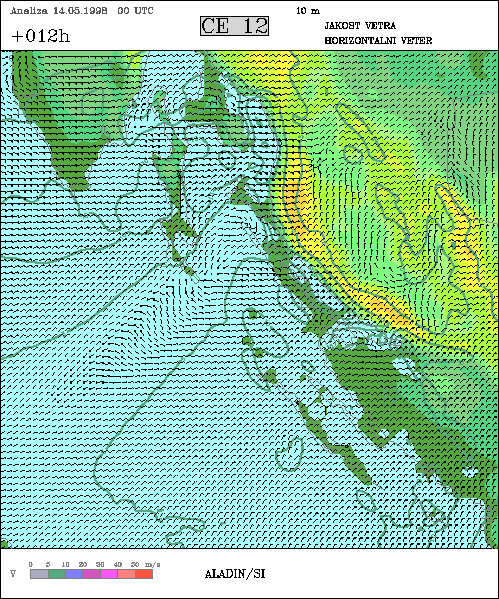
Figure 3: 10m wind over northern Adriatic region for 14th May 1998, 00UTC +
12h, obtained by dynamic adaptation of ALADIN/SI results to the resolution of
2.5 km.
Doina BANCIU : report in the next Newsletter.
Marta JANISKOVA : report in the next Newsletter.
The lateral boundary problem in a semi-Lagrangian limited area model has been studied as well as the impact of the current solution of the coupling problem on the conservation of the studied advection scheme.
The problem arises near the boundary when a semi-Lagrangian trajectory goes out of the domain. Since in the vicinity of the true origin point there is no information about the flow, an artificial procedure takes place in order to bring back the origin point on the boundary row. Currently it is done by simple rectangular projection. A comparison study between this technique and other solutions with respect to the accuracy has already been done in Météo France.
A special structure of the model domain has been created. The so-called intermediate zone has been doubled and divided into two subzones. The inner one keeps the same profile of the coupling function as in the original model while in the outer subzone the coupling coefficient equals to 1. Thus in the outer coupling subzone we have realistic information coming from the global model and no information from the local computation is held. Series of two different experiments have been run. In the first we project the origin points of the semi-Lagrangian trajectories back to the boundary row of the "true" coupling zone (inner subzone). The setup of these group of tests corresponds to the current operational solution. In the second group of experiments instead of projection of the origin points we keep the same position and use the information available in the outer subzone in order to assess the values to be advected along the trajectory. The setup of these group of tests we considers would bring us more realistic results.
The preliminary tests show almost no impact of the current boundary problem solution on the conservation properties of the 2 time level semi-Lagrangian technique. Obviously the used profile of the coupling function provides significant dumping of the possible error we introduce at the boundary. Additional series with modified coupling function profiles is carried out.
The study of the conservation properties will be extended to the stability of the 2 time level semi-Lagrangian with respect to the recent development in the technique.
The study of the frontal collapse of an academic baroclinic wave in the periodic version of ALADIN has been continued. In December 1997, a new basic state was defined with a closer link to the standard bibliographical references (with a closed jet at the tropopause and smooth gradients). Due to the insufficient resolution, the wave saturates too quickly and no frontal collapse is observed. However, a preliminary experimental setup is obtained with a first 5-day integration during which the wave evolves almost linearly, followed by a non-linear evolution for which the horizontal diffusion is switched off in the troposphere and lower stratosphere. Furthermore, the sensitivity to several horizontal interpolations has been tested in the semi-Lagrangian scheme. In future, it is proposed to use embedded grids to inverse locally the resolution.
(more details Dominique Giard )
On March 16th all the operational ALADIN suites have successfully moved to the "ISBA stuff". This stamp covers several modifications.
First a new land surface parameterization is used, an up-to-date version of the ISBA scheme (Interaction Soil Biosphere Atmosphere), developed at CNRM. The description of the impact of vegetation and soil characteristics is improved, with the parameterization of evapotranspiration from plants, interception of rain by foliage, freezing of water in the soil, variations of the thermo-hydric properties of soil with texture and moisture, ... The parameterization of snow has not changed. 7 variables are now used to describe soil and surface :
with a variable soil depth, roughly from 10 cm for stony areas to 3 m for forests. A diagnostic variable (saved from step to step), the resistance to evapotranspiration, has also been added. And 7 new "constant" fields are used to describe soil and vegetation :
LAI limits the maximum interception water content, whereas LAI/Rsm controls transpiration.
Consistently the description of surface has been improved. New fields have been added of course, but databases have also changed. Over sea, albedo and emissivity now change with the climatological sea-ice extension, as defined by climatological SST. Over land, most surface characteristics show an annual cycle, as does vegetation. Only soil depth, soil texture, emissivity and land use type (and orography of course) are really constants. A high resolution (2km) dataset has been used to derive vegetation features over a large part of Europe.
Figs. 1 : Fraction of vegetation over Europe for January (a) and July (b)
in ARPEGE (a)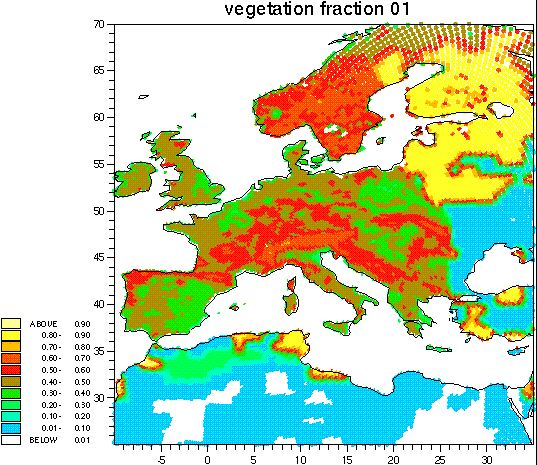 (b)
(b)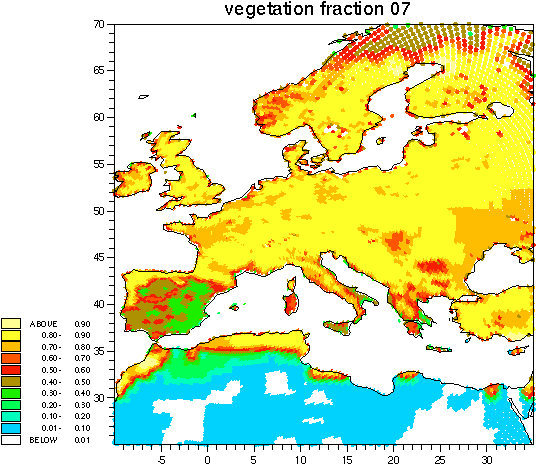
As an example, Figs 1a-b show the vegetation cover for ARPEGE over Europe, for January and July. The original dataset will be extended northwards and eastwards, probably this summer.
A new analysis scheme for soil moisture has been implemented. It is based on optimal interpolation from 2m temperature and relative humidity errors. In order to avoid spurious corrections when soil moisture is clearly not responsible for such errors, systematic biases on 2m temperature are considered and analysis is switched off in unsuitable situations. Optimal interpolation coefficients now depend on soil and vegetation features, in agreement with the formulation of surface fluxes. The analysis scheme for soil temperature has not changed. The readjustment towards climatology, previously introduced to avoid severe drifts where/when there are no observations, has been kept only for Tp. It has been reduced by a factor 10 for Wp , and suppressed, since useless, for Ts and Ws. Wl and Wpi are not analyzed
The use of "clim" files is now required both for post-processing applications and the preparation of coupling files. The underlying reasons are the following :
The main set of modifications has been tested in a first ARPEGE parallel suite, last autumn (September / October 1997). The results were quite convincing, with a overall improvement in the scores for SYNOP observations : 2m temperature and relative humidity, but also mean-sea-level pressure or 10m-wind. The global hydrological balance was also better described, mainly due a reduction in evaporation. Some residual problems were noted on cold regions, since soil freezing parameterization was not coded yet. The second ARPEGE parallel suite (February / March 1998) was as successful as the first one. Figures 2a-d show some examples of scores to SYNOP. The previous problems on the Alps and Scandinavia have disappeared. The operation was not so easy for ALADIN, the main problems being related to the computation of ALADIN "clim" files and Full-Pos. Once the bugs corrected, the parallel suites showed a small improvement for ALADIN-FRANCE, but clearly better results for ALADIN-LACE.
However, some more improvement are required. According to the results of M. Szczech, the parameterization of soil water freezing will be retuned within next winter. The implementation of a more sophisticated snow scheme, which requires more developments and tests (as shown by A. Dziedzic), will be delayed. Concerning databases and configurations 923, the first step will be the extension northwards and eastwards of the initial fine dataset over Europe, with an increase in resolution (1km). Higher resolution (i.e. better than 1°) data for other parameters (e.g. soil characteristics) or other domains (e.g. Morocco, where ISBA is not so good) will be introduced as soon as available. Besides, the short-term solutions to the problems encountered in ALADIN during the parallel suite must keep temporary. R. El Khatib will develop a "physically meaningful" biperiodization procedure for surface fields in E923 and Full-Pos. A clean solution to the problem of missing data in c923/e923 (e.g. when the initial and final land-sea masks disagree) has also to be coded. Some more developments on the assimilation of surface fields are already under tests. M. Zitouni is currently studying the impact of surface and soil assimilation in ALADIN, i.e. an intermediate solution between dynamical adaptation and full data assimilation (as in Albachir). Some further improvements in surface analysis (for 2m temperature and relative humidity) and further tunings for soil water analysis will also be useful.
Some references for more details :
Noilhan, J. and S. Planton, 1989. A simple parameterization of land surface processes for meteorological models. Mon. Wea. Rev. , 117 , 536-549.
Noilhan, J. and J.F. Mahfouf, 1996. The ISBA land surface parameterisation scheme. Global and Planetary Change, 13 , 145-159.
Giard, D. and E. Bazile, 1996 Assimilation of soil temperature and water content with ISBA in ARPEGE : some new developments and tests. HIRLAM Newsletter Number 24, pp.34-42. Swedish Meteorological and Hydrological Institute, S-60176 Norrkopping, Sweden.
Giard, D. and E. Bazile, 1997. Recent developments in soil assimilation. In HIRLAM Newsletter Number 26. Swedish Meteorological and Hydrological Institute, S-60176 Norrkopping, Sweden.
Champeaux, J.L. and Le Gléau H., 1995. Vegetation mapping over Europe using NOAA/AVHRR. In The 1995 Meteorological Satellite data users Conference . 4-8 September 95. Winchester U.K.
Figs. 2 : Distance to SYNOP observations for 72h ARPEGE forecasts (average
along the parallel suite), for some domains : (a) 2m temperature, (b) 2m
relative humidity. PA refers to the operational suite (old surface scheme) and
PAD to the parallel suite (ISBA). The corresponding rms and mean errors
(forecast - observations) and the number of observations used in the
statistics are plotted. (a) TEMPERATURE CORR.
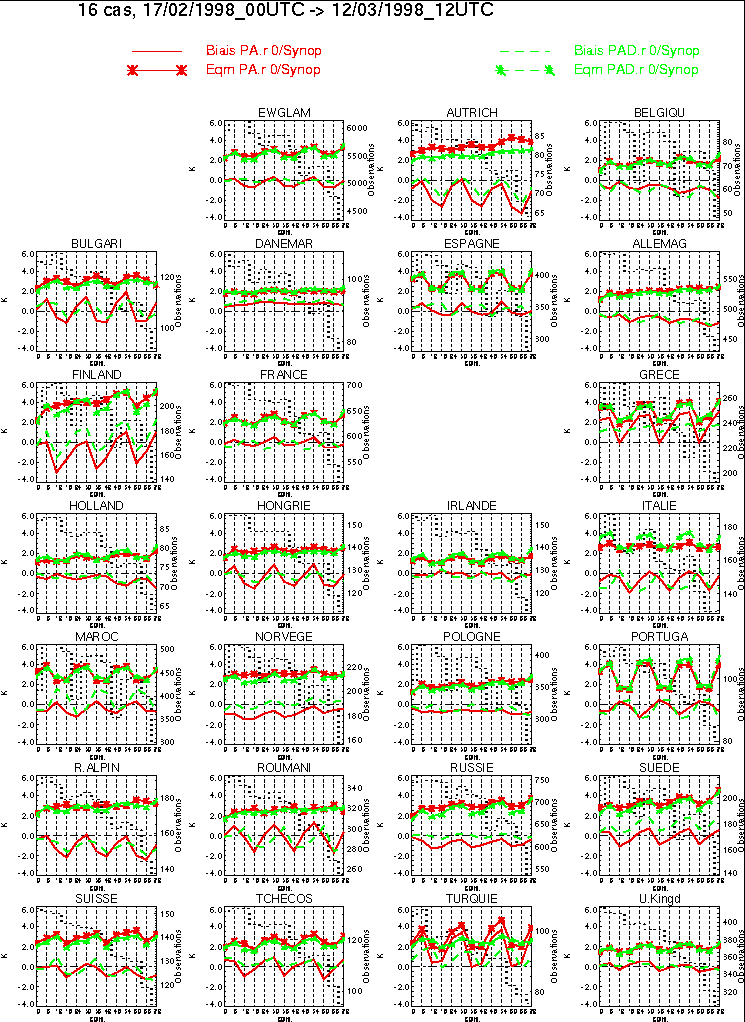
(b) HUMIDITE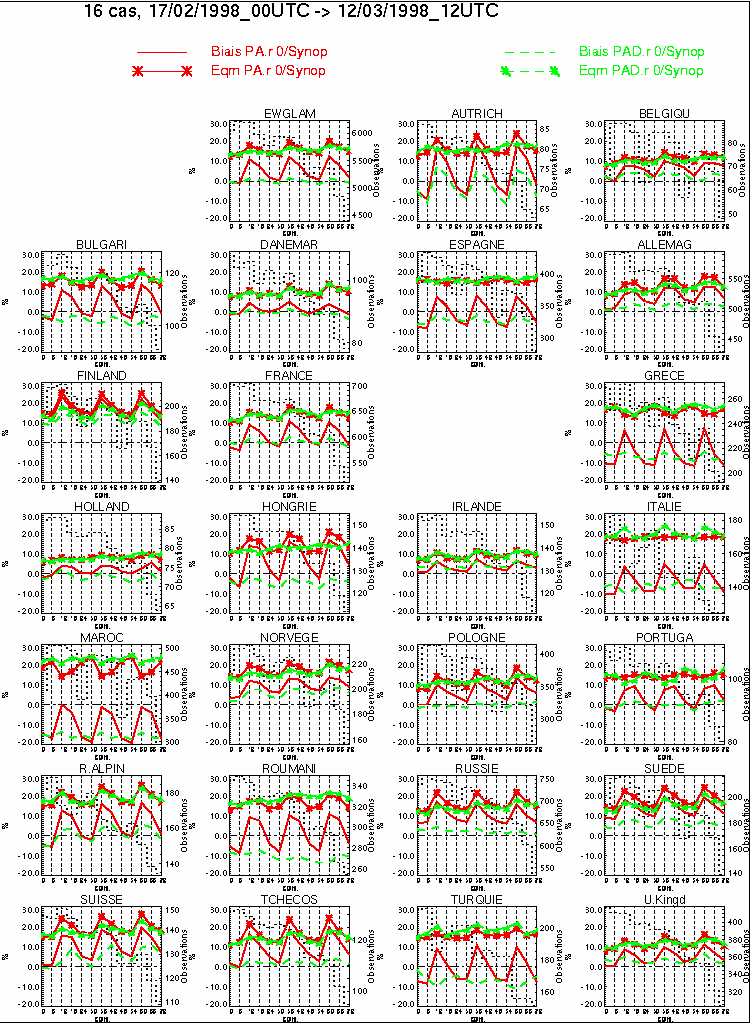
(Marta Sallai Buranszki - HMS)
The idea to perform subjective evaluation of the ALADIN model was originally coming from Ales Poredos (Hydrometeorological Institute of Slovenia). The goal of the subjective evaluation is addressed to give some additional information about the performance of ALADIN model on top of the already existing objective verification scores. After discussions with the relevant persons inside RC LACE it was recommended to start the operational evaluation in February, 1997. At the ALADIN workshop in Budapest (16-18 June, 1997) the first experiences were presented and rediscussed
Introduction
The subjective method have been used at the Hungarian Meteorological Service since 10 February 1997. The 06-18h and 18-30h ALADIN LACE outputs were evaluated according to their applicability in predictions of wind, cloudiness, minimum and maximum temperature, precipitation distribution and precipitation quantity. The first results were presented at the ALADIN workshop in Budapest studying the period 10 February 1997 - 10 May 1997. ( M. Sallai Buranszki, F. Wantuch : First experiences with the subjective evaluation system of ALADIN at HMS, Proceedings of the third RC LACE/ALADIN workshop Budapest, 16-18 June, 1997). After the workshop we continued the evaluation without changing of the method till the end of 1997. In the beginning of 1998 we decided to make some modifications (most of them were proposed on the round-table discussion of the workshop) regarding the type of the weather situations, the ranking of the different weather parameters and we extended the method for the verification of ECMWF outputs too, in order to compare the applicability of the models.
The goal of this paper is to review the results of the evaluation for the period 1 June 1997 - 31 December 1997 using the same method as for the previous period.
The application of the method in Hungary
The 06h - 18h and 18h -30h 00 UTC ALADIN forecasts are evaluated separately for the Western and Eastern part of the country. In the absence of sea and mountain areas only the plane and in some cases the hill regions are studied.
To classify the different weather situations we used the following 7 types:
For the extreme situation the following codes were used:
The evaluated parameters were:
The forecasters, who made the evaluation compared the ALADIN model outputs with the observations using hourly SYNOP data from 33 SYNOP stations from Hungary, and also precipitation and min/max temperature information from 77 climatological stations. The evaluator had to take into account the satellite and radar imagery too. On the basis of this information the forecaster ranked the agreement between observations and forecasts using the ranks between 1 (bad) and 3 (good).
Before beginning the evaluation we proposed some guidance to the forecasters to help in the ranking of the parameters, but the consideration of this guidance is not obligatory of course. The proposal is as follows:
· Total cloud cover
the difference in the quantity of cloud is
+ 0.2
· Wind
the difference in the speed is + 2 m/s
the difference in the speed is + 3 m/s
· Temperature
· Precipitation distribution
· Precipitation quantity
5-20 mm: the difference is + 2-4 mm
more then 20 mm: the difference is +
5-10 mm
5-20 mm: the difference is + 4-6 mm
more then 20 mm: the difference is +
10-15 mm
ALADIN evaluation
The evaluation period is since 1 June 1997 till 31 December 1997 (214 days).
The number of the correctly evaluated cases is 601 (304 for the Western part and 297 for the Eastern part of the country). The results are as follows:
· Frequencies of synoptic situations for the period
Figure 1. shows the frequency of the occurrence of the different weather
situations. 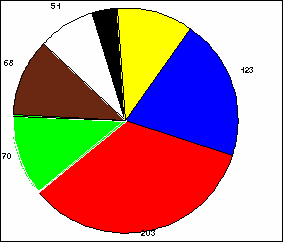 Fig. 1.
Fig. 1.
We can see, that in the evaluation period the most common description of weather situation was anticyclonic (203 cases). The second most common situation was the cyclonic (123 cases) and there were only 21 warm front situations. We have to mention that in the previous period, presented at the ALADIN workshop in Budapest the frequency of the occurrence of the different weather parameters was similar as for this period.
· The rate of successful forecasts of the different parameters
To study the rate of successful forecasts we averaged the ranks of the predicted parameters. The results are shown on the following figures.
1. The rate of successful forecasts of the different parameters without
separating the weather types and the extreme situations are shown on Figure 2.
parameters |
wind |
cloud |
max. temp. |
min. temp. |
precip. dist. |
precip.quant |
evaluation |
2.68 |
2.61 |
2.42 |
2.54 |
2.75 |
2.64 |
Fig. 2.
Figure 2. shows that in this period the prediction of the maximum and minimum temperature seems to be the weak point of the model for Hungary. The reason may be the great number of the inversion layer situations near the surface ("cold air pad") in the autumn and winter season. The forecast of wind was improved, with respect to the results with the experiences of the previous evaluation period. The precipitation distribution seems to be the best ranked parameter.
2. When the weather situations and the extreme situations are separately studied we can draw the following conclusions:
· Wind
|
|
Fig.3 The rate of successful wind forecasts in the case of the different weather situations and the different extreme situations
When the wind is the predicted parameter, we can say that the rate of successful forecasts is significantly better as it was in the previous period. The ranks are the best in the case of anticyclonic and weak pressure gradient weather situations. The most unsuccessful forecast are in the case of cold front.
Studying the extreme situations, we can see, that the wind forecasts are the most unsuccessful in the case of strong wind episode. In the previous evaluation period the results were the same, and this fact correspond to the experiences of the forecasters, i.e. in the case of strong wind episode the forecast of the wind is significantly underestimated.
· Cloudiness
|
|
Fig.4. The rate of successful cloudiness forecasts in the case of the different weather situations and the different extreme situations
When the cloud coverage is the predicted parameter, the rate of successful forecasts is the best in cyclonic and anticyclonic weather situations. In the case of warm front and weak pressure gradient the rate of successful forecasts is near the average. The evaluators gave the worst rank when the weather situation was cold front, as it was happened in the previous evaluation period.
Studying the extreme situations we can see that the rank is the best in heavy precipitation situation, and significantly the worst in cold air pad situation. The experiences of the forecasters are similar, i.e. in the case of cold air pad situation, when the inversion layer is thin the temperature and cloudiness forecasts are not always correct.
· Maximum temperature
|
|
Fig.5. The rate of successful maximum temperature forecasts in the case of the different weather situations and the different extreme situations
The best ranks were given when the description of the weather situation was cyclone, cold front and warm front. The rate of successful forecasts is significantly the worst in the case of warm advection and anticyclonic weather situation. In the previous period the evaluation of the maximum temperature in anticyclonic weather situation was significantly better. The reason is, that in autumn and winter the cold air pad situation occurs very often, when the weather situation is anticyclonic. The study of the extreme situations shows exactly, that significantly the worst ranks was given in the case of cold air situation (as we mentioned above).
· Minimum temperature
|
|
Fig.6. The rate of successful minimum temperature forecasts in the case of the different weather situations and the different extreme situations
Studying the rate of successful forecasts in the case of minimum temperature we can draw similar conclusions, as in the case of maximum temperature. The worst ranks were given also when the weather situation was warm advection and anticyclone and in particular in the case of "cold air pad" situation.
· Precipitation distribution
|
|
Fig.7. The rate of successful precipitation distribution forecasts in the case of the different weather situations and the different extreme situations
The most successful forecasts are in the case of warm advection. When the weather situations are cold advection and anticyclone, the forecasts are also good evaluated. The rate of successful forecast is the worst in "weak pressure gradient" weather situation. As the strong convection event is many times incident to the "weak pressure gradient" weather situation, so studying the extreme situations we can see, that the ranks are the worst in "CU" situation.
· Precipitation quantity
|
|
Fig.8. The rate of successful precipitation quantity forecasts in the case of the different weather situations and the different extreme situations
When the predicted parameter is the amount of the precipitation, we can see, that the ranks are the best in warm advection, cold advection and anticyclonic weather situations, and the worst in the case of weak pressure gradient situation similarly as were in the case of the evaluation of the precipitation distribution.
· The results studying separately the different regions and forecast ranges
Finally the following tables show the results studying separately the
different regions (Eastern and Western part of Hungary) and the different
forecast ranges.
region |
wind |
cloud |
max.temp |
min.temp |
precip.dist. |
precip. qua |
East |
2.69 |
2.60 |
2.35 |
2.54 |
2.73 |
2.63 |
West |
2.68 |
2.62 |
2.50 |
2.53 |
2.77 |
2.66 |
Fig. 9. The results for the different region of the country
ranges |
wind |
cloud |
max.temp |
min.temp |
precip.dist. |
precip. qua |
06-18 h |
2.62 |
2.63 |
2.48 (12h t) |
- |
2.76 |
2.62 |
18-30 h |
2.76 |
2.58 |
2.36 (36h t) |
2.54 |
2.75 |
2.67 |
Fig. 10. The results for the different forecast ranges
Suggestions and conclusions
Because the evaluation method was the same as in the previous period presented at the ALADIN workshop in Budapest, the suggestions are very similar, i.e. we have to make some modifications regarding the description of the weather situation and to find out, whether the predicted parameters are over or underestimated, using the minus or plus sign before the ranks.
Studying the results we can say, that in the most cases the experiences of the forecasters were confirmed by the statistical elaboration.
- The forecast of the surface wind was improved significantly with respect to the previous evaluation period.
- The precipitation distribution is the best ranked parameter in both evaluation period.
- The maximum and minimum temperature forecasts are ranked worse than in the previous period. The reason is the great number of the "cold air pad" situations. When the inversion layer is thin, the model often overestimates the temperature.
- The precipitation forecast due to the convective processes on summer period is not so successful, especially in the case of "weak pressure gradient" situation.
In the future we shall continue the subjective evaluation with the modifications regarding the type of the weather situation and the ranking of the different parameters, extended the method to the verification of the ECMWF outputs too.
The results are planned to present at the next LACE/ALADIN workshop in Prague.
(more details Jean-marc Moisselin or Francis Pouponneau )
1. Validation of new ALADIN-FRANCE versions
The Control&Monitoring team of Météo-France have started in January 1998 the operational validation of modified versions of ALADIN-FRANCE (in collaboration with CNRM/GMAP and SCEM/TTI). The first test was for CYCLE 18.
The impact of ARPEGE or ALADIN's modifications are systematically examined through score differences against TEMP and SYNOP, with following schema :
00UTC initial data set :
Verification of impact of ARPEGE's modifications on ALADIN
OR verification of impact of ALADIN and ARPEGE's modifications on ALADIN
12UTC initial data set
Verification of impact of ALADIN's modifications
2. Comments of scores : first quarter 1998
The scores (bias and root mean squared error) plotted on the figure correspond to the scores calculated against surface observations SYNOP over the domain ALADIN-FRANCE (FRANP01). Scores are averaged over the first three months of 1998, for each 6 hours time step. Scores contains a large period without ISBA schema.
COMMENTS:
MSLP :
The RMS rises with time-step (from 0.75 to 1.75 hPa).
The bias has a little amplitude during the first 12 hours and decreases
with respect to increasing time step, to the 0.75 hPa value.
CORRECTED TEMPERATURE
The RMS is bigger at 12 and 30 forecast range (2.5 and 2.78°). The
maximum of bias occurs at 18.
PRECIPITATIONS
There is high amplitude of the RMS at 12 and 36 hours (1.8 and 2.0 mm) while
the bias is low (from 0 to 0.1 mm).
NEBULOSITY
The RMS is important, and remains quite constant with forecast range (from
31.4 to 36.2%). The bias is relatively strong (10%).
WIND DIRECTION AND INTENSITY
Despite an initial high value, the bias of wind direction is large at 6 and 24
hours and the bias of wind intensity is strong at 12 and 36 hours. However the
RMS is very high during the whole integration.
HUMIDITY
There is a diary cycle of the error of the RMS and bias (amplitude RMS 14.9%,
amplitude bias : 5%) which are maximum at 12UTC (forecast ranges 12 and 36).
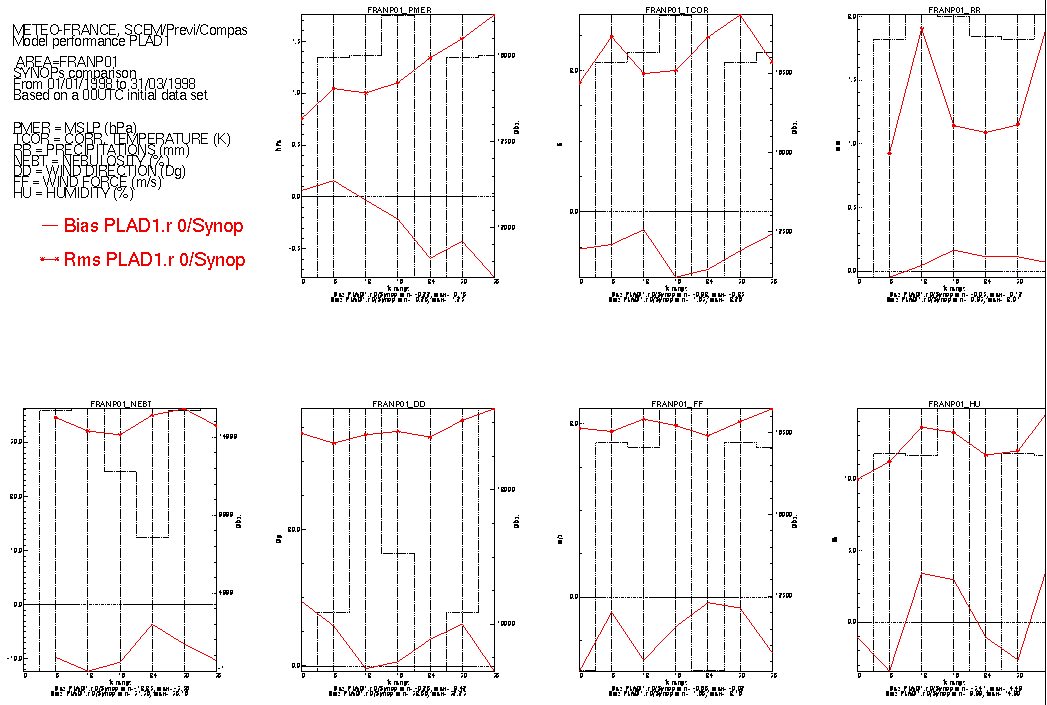
The statistics about the participations in the ALADIN project and the ensuing compilation of the ALADIN developments is drawn up from the contributions sent by the representative of each country. Please find in annex a few graphics illustrating the last summary of the participation in the ALADIN project.
In the next two parts ("Deported developments during the last quarter of 1997" and "ALADIN developments in Toulouse during the first quarter of 1998"), you will find the list of the ALADIN developments (in and outside Toulouse) excepted those detailed in the previous pages : PhD studies, developments for workstation versions or operational suites, work on data assimilation, ... during the quarters concerned by this Newsletter. The following informations concerning the deported developments are obtained from informations you sent.
During this quarter, about 50 persons have worked on ALADIN "at home" (i.e. in their NMS : not in Toulouse) and their global effort represents more than 60 people.month during this period.
1. In Austria
2. In Belgium
3. In Bulgaria
4. In Croatia
5. In Czech Republic
6. In Hungary
7. In Morocco
8. In Poland
9. Portugal
10. In Romania
11. In Slovakia
12. In Slovenia
13. Deported work by Météo-France
|
|
Around 30 persons (2/3 of visitors) have reached the common effort of 45 people.month. Some have contributed to the success of one (at least !) of the following main events and/or have dealt with more specific research or development studies. 1. Main events in Toulouse this quarter the operational cycle AL08. the operational and simultaneous introduction of ISBA in ARPEGE and in all the ALADIN models : it has been a success thanks to the intensive effort of many people in Toulouse, within the visitors, the permanent ALADIN team and people from other teams of GMAP as well, of course, as in each of the 6 other locations (Belgium, Hungary, Morroco, Romania, Slovakia and Slovenia) where the change took also place. |
the ALADIN workshop "on various implementations of the model within ALADIN partners".
the "ALADINthèque" birth
the arrival of much-awaited SUN station for our ALADIN workstation version.
2. Visitors research or development studies
The validation of ISBA especially in soil assimilation was realized.
While waiting for the SUN station to be available in GMAP, AL07 and AL08-t1 were installed and tested on RISC/6000 in Sofia. Then, AL07 and AL08-t1 were also installed in SUN station in GMAP. The code was successfully compiled.
First, the familiarization with ALADIN was realized through some experiments with Digital Filter. Then, the importance of the terms in the equation for lower boundary condition for pseudo vertical divergence was studied. Conclusion is that none of terms in this equation can be neglected and the most important one is pressure gradient term. At least, a new lower boundary condition for vertical divergence was introduced : in fact, a new definition of u and v at the surface. To be consistent with these changes, a new lower boundary condition for vertical derivative of horizontal velocity will be introduced in the next stay (mid-May).
F. Chome: "Training on CANARI in ALADIN"
The work on non-Hydrostatic physics was prepared by assessing the effects of the parametrization of downdraught, of horizontal pressure gradient (in cloud velocity profile computation) (Kershaw & Gregory) and non-Hydrostatic dynamics. Comparative experiments were realized with the 21.07.1992 squall-line over Southern Germany.
The 801 configuration was finalized and the first sensitivity studies were realized with it (study of the sensitivity of the 12 hours forecast errors to the initial conditions).
Experiments were made to tune the parameters of the new soil freezing parametrization introduced in the end of 1997. A library for running ALADIN Verif Pack on CRAY has been developed to verify these experiments.
The 1D version of ARPEGE/ALADIN model was modified by adding CLIMA-ARPEGE configuration which uses another radiative scheme. Then, the ECMWF part of the IFS/ARPEGE was added in the 1D model requiring the interpolation of deep soil variables.
To provide a sound statistical basis for the assimilation system of ARPEGE/ALADIN, the method of Hollingsworth-Loennberg is used to analyze the statistical structure of the errors of wind, geopotential, temperature and humidity in the ARPEGE/ALADIN data assimilation system, by verifying the background against radiosonde data over centre Europe. An estimate of error covariance and cross-covariance of background and observation has been provided, and some comparisons with the statistics obtained by using NMC method have been done. The results show a good agreement in the vertical structure, but with some differences in magnitude. More investigations are undergoing.
3. Research or development studies by the Toulouse permanent staff
A new tool called EDF (EDit Field) has been developed by J.-D. Gril. It reads ALADIN files and creates a simple ASCII file containing latitude, longitude and value of the chosen fields. Zooms are allowed. It is available on CRAY.
With the help of M. Siroka and P. Alary, SPECWOR, a tool to compute and draw spectra for ALADIN, has been updated by C. Fischer. It can now run on CRAY and VPP, but keeps expensive since using configuration E001. Further developments, to by-pass all useless calls and make SPECWOR a more flexible tool, will be performed by J.D. Gril.
Configuration 601 is running for ARPEGE, and will soon for ALADIN, on the latest cycles (C. Fischer)
Digital filter initialization (DFI) is now available for non-Hydrostatic runs. Besides, the DFI code has been modified so as to allow horizontal diffusion along backward integrations. As a consequence, longer time-step can be used at this stage, and the overall cost of initialization may be reduced (D. Giard).
Toulouse_stays.ps , updated on 30-04-98 : visitors expected in Toulouse in 1998 (provisionnal document).
participations_Toulouse.ps , updated on 30-04-98 (5 pages) : graphics statistics of the participation in the Toulouse part of the ALADIN project. Statistics on March 31, 1998.
participations_compare.ps , updated on 31-03-98 (4 pages) : graphics statistics of the participation in the ALADIN project, since the last quarter of 1995, with a comparison of deported work and work realized in Toulouse. Statistics on December 31, 1997.
participations_total.ps , updated on 30-04-98 (4 pages) : graphics statistics of the participation in the Toulouse part of the ALADIN project. Statistics on March 31, 1998 for the Toulouse part and December 31, 1997 for the Deported work.
news9.ps : ALADIN Newsletter 9 (color postscript), updated on 30-01-98 (26 pages)
news9bw.ps : ALADIN Newsletter 9 (black and white postscript), updated on 30-01-98
news10.ps : ALADIN Newsletter 10 (color postscript), updated on 19-05-98
news10bw.ps : ALADIN Newsletter 10 (black and white postscript), updated on 19-05-98
wk_minutes_980330.ps: Minutes from the ALADIN Workshop on various implementations of the model within ALADIN partners held in Toulouse last February (5 pages), updated on 30-03-98
aladintheque.ps : list (with abstracts) of 88 ALADIN documents available in paper format, updated on 19-05-98
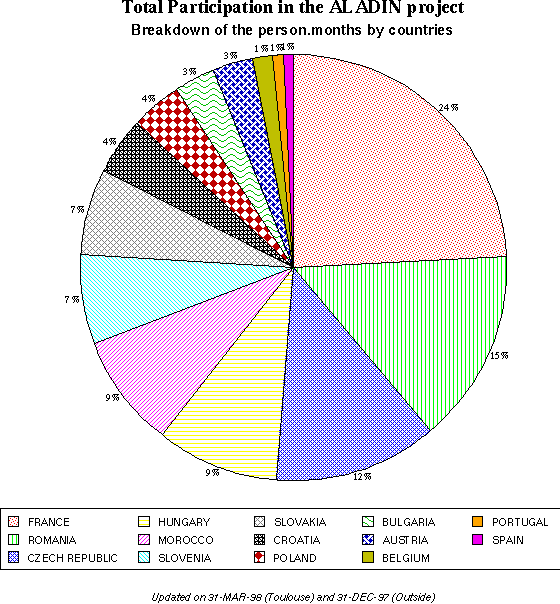
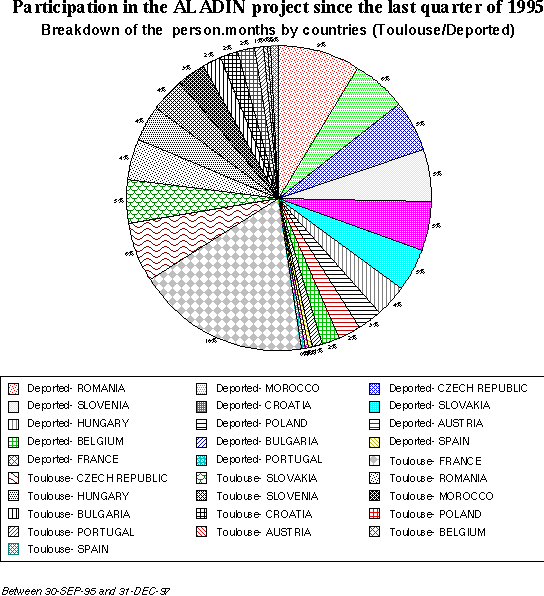
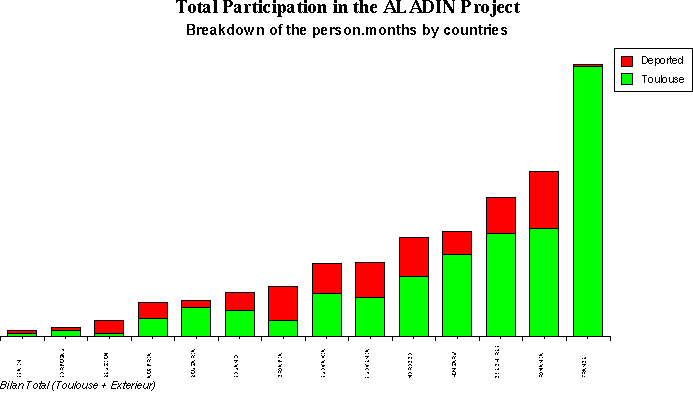
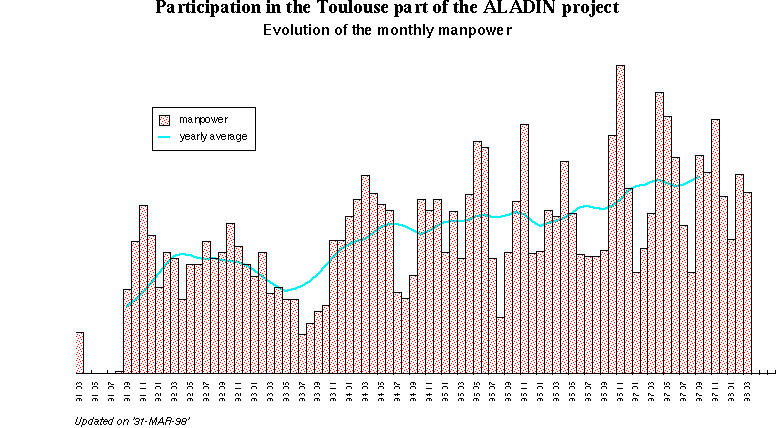
 |
Home |